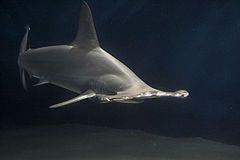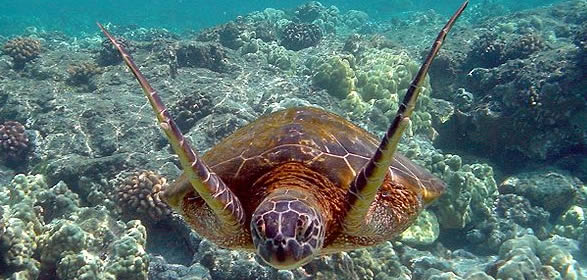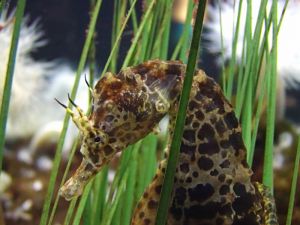Category Archives: Endangered
“Nay” to the regulation of shark fishing from the shoreline
Indian River County – The recent proposal to regulate shark fishing from the shore, may be at an impasse.
Following two months of heated discussions, the majority of the County Commission voted on Tuesday to reject Alan Polackwich’s, County Attorney, draft ordinance, without even allowing the courtesy of a revision.
“(Am I) disappointed? I can’t understand it,” Doug Distl, Carlton condominium manager commented, “This is Indian River County. We’re known for recreation, retired citizens and good things.”
Distl, who submitted his own proposal to ban the baiting and chumming of sharks off the beaches where people swim, has said that he didn’t want the county to become known as a shark fishing destination.
He has said that he is now going to focus on just getting the Indian River Shores, Orchid, and Vero Beach councils to at least regulate shark fishing.
In a 3-2 vote, the commissioners effectively shot down Polackwich’s draft. The motion to reject the proposal was made by Vice Chairman Bob Solari.
This rejection came after the commission had asked Polakwich to revise his proposal and put more focus into it on June 15th. Rather than banning shark fishing and chumming, the commissioners were after authority for lifeguards and sheriff’s deputies to order shark anglers to move their activities off the swimming beaches, and into remote areas.
BP Facing Lawsuit to Stop Burning Sea Turtles
– BP is in some very hot water over their practice of burning sea turtles, while trying to clean up their mess in the Gulf of Mexico. The initiative is being headed by the Center for Biological Diversity and the Turtle Island Restoration Network.
They officially notified the U.S. Coast Guard and BP of their intent to launch a lawsuit for them to stop burning endangered sea turtles alive, and have given an ultimatum of 60 days in order to do so. If the action is not stopped a lawsuit will be filed under the Endangered Species Act.
Todd Steiner, biologist and executive director of the Turtle Island Restoration Network has this to say on the subject “BP is burning turtles alive and it is cruel, heartless and a crime we can’t and won’t allow to continue, sea turtles were critically endangered before BP created America’s worst environmental catastrophe, and every effort possible must be taken to rescue endangered turtles from this oil spill. BP needs to reverse course and help double our efforts to rescue sea turtles, not prevent their recovery.”
The spill really did happen at an inopportune time, as the rare Kemp’s ridley sea turtles started to nest in the Gulf of Mexico.
BP wound up in this mess, as they started a burning process, as they didn’t allow enough time for rescue boats to make a search, and get the sea turtles out of harms way.
Animal Lovers Rejoice! Historic Shark Fin Ban!
On July 1st, Hawaii became the first government in the world to institute a law to ban the sale, distribution and even possession of shark fins, the news is sending ripples all around the globe, and animal advocates everywhere are cheering, and ramping up their efforts to get their governments to do the same.
This new law means that restaurants in Hawaii will not be able to serve shark fin soup, a real delicacy, but the implications are so much greater than a few items on a lunch menu.
The shark has made the jump from predator and food source, to being protected. The new law instituted in Hawaii is aiming to prevent shark finning, a rather gruesome process where, once caught, the fins are removed from the shark, and the rest of it is thrown back overboard.
State Senator, Clayton Hee had this to say about the momentous occasion, “As far as I’m concerned it’s no different than killing an elephant for its tusks or de-horning a rhinoceros for its horn. These are cruel and inhumane practices that have no business in a civilized world”.
It was Senator Hee, with the support of many animal rights advocates, which managed to drum up the votes to make it illegal to have, serve, buy, or sell shark fins.
Other States, such as California, are starting to jump on the band wagon, and even other countries are talking about creating similar laws.
Not surprisingly, China is where a lot of the efforts are being made. WildAid launched a campaign in China using NBA superstar Yao Ming, to get people to stop buying shark fins, and stop eating shark fin soup.
Malaysian researcher tries to save pygmy seahorse from reckless scuba divers
Scuba divers are threatening the survival of the infinitesimal Pygmy seahorses found on the coral reefs around Sabah’s east coast islands in Malaysia.
Sabah, a Malaysian state situated in the northern part of the island of Borneo, is home to two species of pygmy seahorse Hippocampus bargibanti and Hippocampus denise. Both species are fairly widespread in South East Asia and are found on coral slopes from southern Japan and Indonesia to northern Australia and New Caledonia.
Barely five years ago, the pygmy seahorses were discovered at popular Sabah divespots, such as Bodgaya, Mabul and Pulau Sipadan, and since then dive operators have brought large numbers of scuba divers to see the tiny creatures. In some of the most popular spots, over 100 divers can be seen exploring the reef simultaneously and this puts a lot of stress on the reef and its inhabitants.
Photographing divers have for instance been spotted breaking off sea fans – the natural habitat of the pygmy seahorses – and moved them just to get a better angle for their pictures.
In an effort to improve the conditions for the seahorses, marine biologist Yeong Yee Ling of the Universiti Malaysia Terengganu has held a two-day seminar about how to behave when scuba diving in seahorse habitat. The seminar was attended by 57 participants, including representatives from most of the 15 dive operators based in Semporna. Sabah Parks, the conservation-based statutory responsible for conserving the scenic, scientific and historic heritage of the state of Sabah, was also involved in the event.
“Our hope is that the discussions from the seminar would eventually be synthesised into a code of conduct for divers. We are thankful the dive operators have been supportive of this effort,” said Yeong, who has been researching pygmy seahorses for the past three years.
The seminar was funded by the Shell Malaysia’s Sustainable and Development Grant.
Dolphin hunting banned in Bihar

“A close watch is being kept on the ghats of river Ganga by the magistrates, police officials and block development officers to stop hunting and fishing of the mammals,” senior officials said.
Patna District Magistrate J K Sinha said that instructions from chief minister has been passed
to senior officials, including sub-divisional officers, magistrates, police officers and block development officers to ensure close surveillance and act swiftly to stop hunting of the aquatic animal.
“Schools will take steps to aware the students about the gangetic dolphin which would
boost eco-tourism in the region,” he added.
Although the Wildlife Protection Act of India mandates dolphin conservation as a priority, little has been done at the government level to implement or enforce the law.
Where is Bihar?
Bihar is an Indian state located in the eastern part of the country. It is bordered by Nepal to the north, Jharkhand to the south, Uttar Pradesh to the west, and West Bengal to the east. The state is bisected by the Ganga River which flows through the middle of the state from west to east.
What is Ganga?
Outside India, the Ganga River is more commonly known as the Ganges River.
What is the Gangetic dolphin?

It is referred to as the Blind dolphin due to its poor eye-sight which is probably an adaptation to the murky waters of the Ganga River.
Heat wave makes basking sharks head for northern shores
After being boosted by the recent heat wave, massive amounts of zooplankton is now attracting record numbers of basking sharks into British and Irish waters.
Last year, 26 basking sharks were reported from the most southerly headland of Cornwall during a 10 week long period. This year, 900 sightings have been recorded since the beginning of June.
“Last year we had a really poor year because of the weather. But even though temperatures have obviously picked up, we never expected to see the sharks in such large numbers,” saysTom Hardy of Cornwall Wildlife Trust, coordinator of the south-west basking shark project.
Record breaking numbers of basking sharks are being reported from the other side of Irish Sea as well. In June alone, the Irish Whale and Dolphin Group reports having seen no less than 248 basking sharks.
“In a three-day period we tagged more than 100 sharks in just one bay in north
Donegal,” says Simon Berrow of the Irish Whale and Dolphin Group. “You only ever see five or six of these creatures on the surface, which doesn’t reflect what’s going on under the water.”
From the Isle of Man, 400 sightings have been reported since early May.
‘”We saw a lot more in May than is usual and after a couple of quiet weeks sightings are picking up again,” said Fiona Gell, marine wildlife officer for the Isle of Man government.
Very little is known about the basking sharks, but the Irish Whale and Dolphin Group is currently carrying out a pioneering tagging project in hope of furthering our understanding of these basking giants. Simultaneously, the 47 wildlife trusts found across the UK, the Isle of Man and Alderney are working to identify basking shark hotspots.
Will the future bring us Japanese super tuna?
A Japanese team of scientists are now announcing that they are close to completing genome sequencing of the Bluefin tuna. Once they have reached this goal, their next project will be to use their knowledge to create a tuna breeding program for a new type of tuna specially designed for aquacultures.
The wild tuna populations have become severely depleted due to overfishing and the WWF has warned that the Atlantic Bluefin tuna will be eradicated within three years unless radical measures are taken to safeguard remaining specimens.
“We have already completed two computer sequencing runs and have around 60 per cent of the tuna genome,” says Dr. Kazumasa Ikuta, director of research at the Yokohama-based Fisheries Research Agency. “We expect to have the entire sequence in the next couple of months. We plan to use the sequence to establish a breeding programme for bluefin tuna as most aquaculture farmers presently use wild juveniles. We want to establish a complete aquaculture system that will produce fish that have good strength, are resistant to disease, grow quickly and taste delicious.”
The genome sequencing is the result of the collaborative efforts of scientists from Japan’s Fisheries Research Agency, Kyushu University, and The University of Tokyo.
Saving the sea cucumber
The work towards replenishing depleted stocks of wild sea cucumber with captive hatched ones is moving forward at a steady pace; two Philippine hatcheries has now successfully managed to hatch sea cucumbers outside their natural habitat and one batch, comprised of roughly 2,000 juveniles, has been released inside sea pens in the Philippines.
The sea cucumbers, a broad range of species belonging to the family Stichopodidae, are currently facing both overharvesting and habitat destruction in the wild, and the two Philipine hatcheries are both part of a research project carried out by the University of the Philippines Mindanao (UPM); a project aiming to mitigate the problem of overharvesting through sea
farming.
The first hatchery is a 6,000-square-meter laboratory located within a Barangay Binugay resort owned by the JV Ayala Group of Companies, while other one is situated inside Alson’s, an intensive tilapia operator.
The Barangay Binugay laboratory does not have any breeding stock; instead it collects the eggs from wild sea cucumbers, place them in a tank and fertilize them using drops of sperm – a method inspired by a Vietnamese sandfish sea cucumber hatchery and grow-out facility in tilapia .
The first Philippine batch of tiny cucumbers, each weighing no more than three grams, has now been released inside sea pens near the Barangay Binugay laboratory. Carefully, each individual cucumber was buried just below the surface of the soft sea bottom inside 78-square-meter Australian-designed sea pens.
With a history dating back to at least the Sultanate days in Mindanao, sea cucumber trading is a time honoured tradition as well as an important source of income for the Philippines. The country is currently the second largest exporter of beche-de-mer (dried sea cucumber) in the world, second only to neighbouring Indonesia, and diminishing cucumber populations are threatening the livelihood of countless families.
Beche-de-mer is currently priced at roughly 4,500 Philippine pesos per kilogram (roughly 94 USD/kg), and since large specimens are becoming increasingly rare purchasers are no longer very discerning when it comes to size. Even small cucumbers that should have been left to mature can now be sold to unscrupulous purchasers.
Did you know…..?
… that sea cucumbers are known as the earth-worms of the sea since they recycle detritus and burrow under the sand? These animals carry out an essential ecological task as they continuously shift and mix the sea bead and if they were to disappear it would have serious consequences.
… that at depths below 8.8 km (5.5 miles), sea cucumbers comprise 90% of the total mass of the macro fauna?
… that sea cucumbers aren’t appreciated as food only; some people believe them to be effective against arthritis and high blood pressure?
…that sea cucumbers have been observed engaging in mass-spawnings triggered by the moon? One species is for instance known to spawn three nights after the full moon, while two other species have been seen spawning three nights after the first quarter moon.
… that sea cucumbers have been traditionally used as an aphrodisiac and that some people still use them for this purpose today?
…that large sea cucumbers often are harvested by so called hookah diving, where divers breathe through long tubes connected to an oxygen compressor aboard a boat instead of using normal scuba tanks.
Congratulations, it’s a tuna!
In a world first, the Australian company Clean Seas Tuna has managed to successfully rear Southern bluefin tuna (Thunnus maccoyii) in captivity. This breakthrough opens up the way for the development of an alternative to wild-caught tuna.
Clean Seas Tuna announced on April 20 that their tuna broodstock had spawned continuously during a 35-day period from March 12 to April 16, and that the company now had succeeded in raising 28-day-old 2.5 cm tuna fingerlings. During the breeding period, over 50 million fertilised eggs and 30 million larvae were produced by the captive held tunas.
“This is equal to Armstrong walking on the moon,” says an elated Hagen Stehr, chairman of Clean Seas Tuna. Clean Seas Tuna now hope to breed tuna in their facilities off Port Lincoln. “The achievements are world firsts and major stepping stones to present the world with a sustainable tuna resource for the future. There are a number of other hurdles to overcome, but Australia can now achieve total sustainability in tuna.“
According to Fisheries Research and Development Corporation executive director Dr Patrick Hone, farm raised tuna can be a solution to the problem of falling world-wide fish stocks and increased seafood consumption.
“Australia uses 450,000 tonnes of fish a year of which 70 per cent is imported,” says Dr Hone. “Our goal is to lift farmed finfish production from about 50,000 tonnes to 100,000 tonnes annually by 2015.”
Large-scale commercial fish farming is however not a completely unproblematic endeavour from an ecological point of view and farmers will be forced to find solutions for sustainable water management, run-off handling, and food procurement if they truly wish to make farmed tuna an environmentally friendly alternative to wild caught fish. It is however no doubt that it could provide the wild tuna population with a well needed chance to recover.
Multi-million dollar marine life contraband ring busted by the Florida Fish and Wildlife Commission
A six-month long investigation by the Florida Fish and Wildlife Commission (FWC) has led to the arrest of seven adults and one juvenile in Tampa. The arrested persons are believed to have been involved in various illegal activates concerning marine life, including catching protected sharks, sea horses, peppermint shrimp and bay scallops in Floridian waters, and exporting illegally obtained marine life to Europe. They are also suspected of having sold bait fish and bait shrimp as food for human consumption.
According to the FWC, the ring is believed to have operated for at least five years before attracting the attention of FWC. The ring lost a lot of animals due to poor maintenance, but the FWC still believes the group managed to sell $600,000 worth of peppermint shrimp alone.
The Florida Fish and Wildlife Conservation Commission came into existence on July 1, 1999. The Investigations Section of the commission conducts both overt (uniform) and covert (plainclothes) investigations, and one of their tasks is to target hard-core commercial violators by conducting long-term undercover investigations. In 2003, the Investigations Section made 554 arrests/warnings and seized 130 illegally possessed specimens of fish and wildlife including a cougar, tigers, leopards, primates, exotic deer, venomous reptiles, protected birds and exotic aquatic species.






